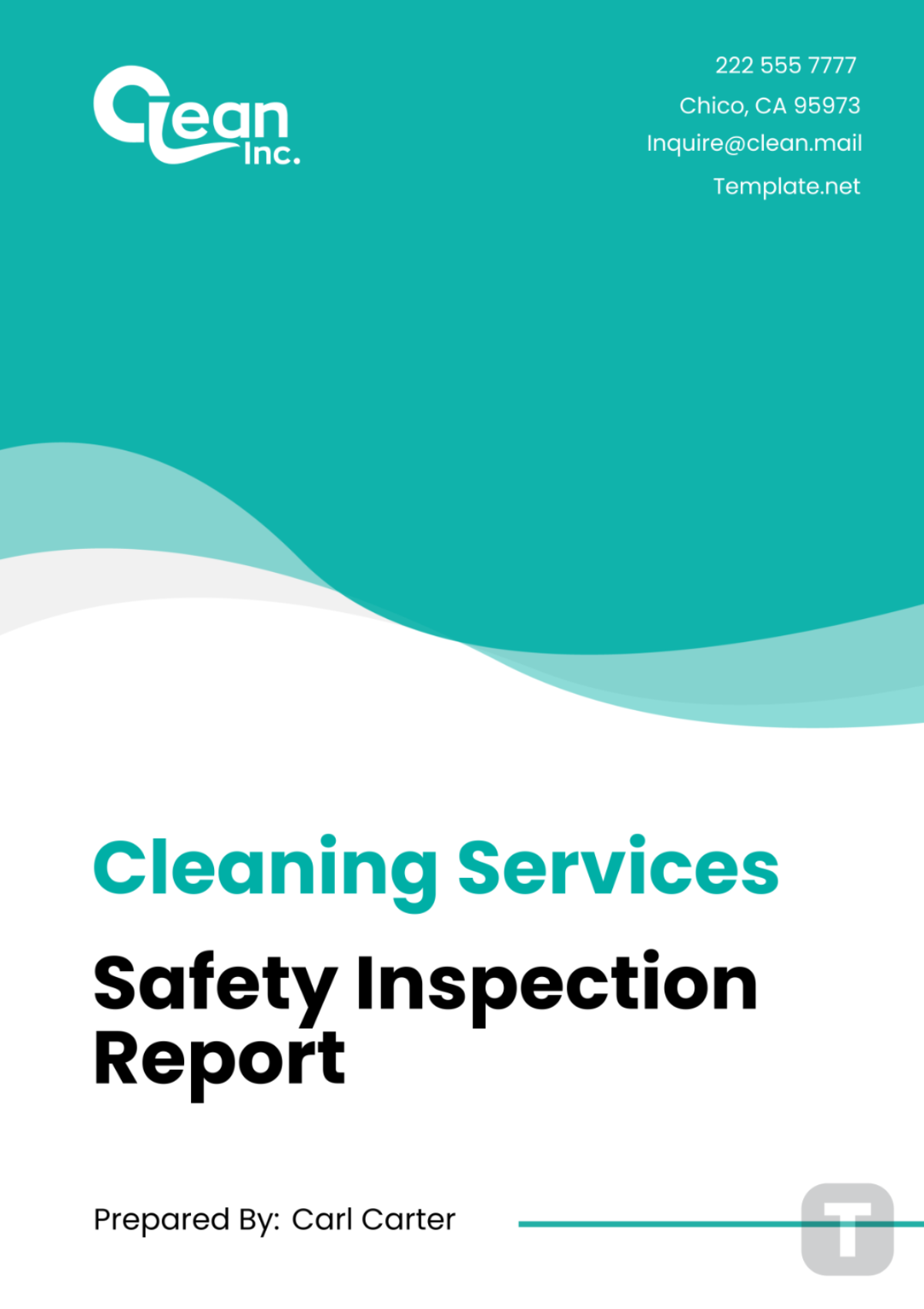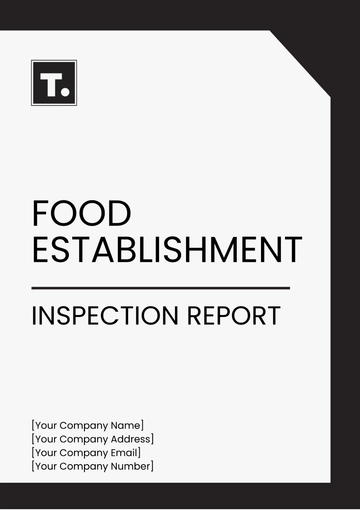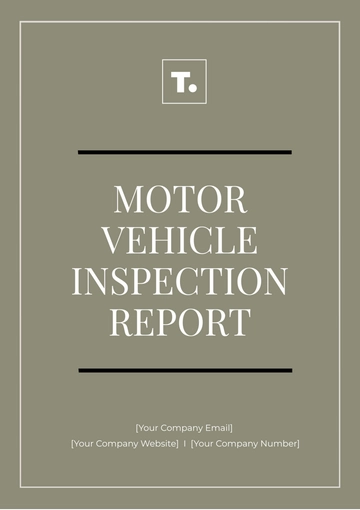Free Cleaning Services Safety Inspection Report

Client Name: | [Client's Name] |
Client Address: | [Client's Address] |
Date of Inspection: | [Date of Inspection] |
Inspection Conducted By: | [Inspector's Name] |
Cleaning Services Provider: | [Your Company Name] |
I. Introduction
This Cleaning Services Safety Inspection Report has been prepared by [Your Company Name] following a comprehensive assessment of the safety conditions at the premises of [Client's Name]. The purpose of this inspection is to identify potential hazards and ensure a safe working environment for our cleaning staff during service delivery. The findings and recommendations outlined in this report aim to facilitate effective risk management and compliance with safety regulations.
II. Hazardous Materials Assessment
Ensuring the safe handling and management of hazardous materials is paramount to maintaining a secure and healthy environment within any facility. The Hazardous Materials Assessment section of this report focuses on evaluating the storage, handling, and disposal practices of potentially harmful substances at [Client's Name]'s premises.
By conducting a thorough examination of chemical inventories, material safety data sheets (MSDS), and personal protective equipment (PPE) usage, we aim to identify any potential risks associated with hazardous materials and provide recommendations to mitigate these risks effectively. This assessment underscores our commitment to prioritizing safety and regulatory compliance in our cleaning operations, safeguarding both our personnel and the occupants of the facility.
Chemical Inventory: A thorough inventory of all cleaning chemicals present on the premises was conducted. Chemicals were properly labeled, stored in designated areas, and secured to prevent spillage or unauthorized access.
Material Safety Data Sheets (MSDS): Verification of the availability and accessibility of MSDS for all cleaning chemicals used on-site. MSDS were found to be up-to-date and stored in a centralized location for easy reference.
Personal Protective Equipment (PPE): Assessment of the provision and utilization of appropriate PPE, including gloves, goggles, and respirators, when handling hazardous chemicals. Adequate PPE was provided, and cleaners were observed using it as required.
Material Storage Conditions: Assessment of storage conditions for cleaning chemicals, including temperature control and segregation from incompatible materials. Chemicals were stored in well-ventilated areas away from heat sources and separated from reactive substances to prevent potential hazards.
Spill Response Preparedness: Evaluation of spill response procedures and availability of spill containment kits or absorbent materials. Adequate spill response measures were in place, including the provision of spill kits and staff training on proper cleanup procedures to minimize environmental and health risks.
Chemical Handling Practices: Observation of proper chemical handling practices, such as dilution protocols and use of secondary containment measures. Cleaning staff demonstrated safe handling techniques, including diluting concentrated chemicals in designated areas and avoiding direct skin contact.
III. Electrical Safety Inspection
The Electrical Safety Inspection section of this report is dedicated to assessing the integrity and functionality of the electrical systems within [Client's Name]'s premises. Electricity is a vital component of modern facilities, yet it poses inherent risks if not managed properly. Our inspection focuses on identifying potential hazards such as faulty wiring, inadequate grounding, and overloaded circuits that could compromise the safety of both occupants and cleaning staff.
Electrical Outlets and Wiring: Examination of electrical outlets, switches, and wiring for signs of damage or wear. All electrical fixtures were found to be in good condition, with no exposed wires or malfunctioning outlets identified.
Appliance Safety: Inspection of electrical appliances used during cleaning operations, such as vacuum cleaners and floor scrubbers. Appliances were checked for proper grounding, insulation, and functionality, ensuring safe operation.
Electrical Hazards Mitigation: Recommendations provided for the installation of Ground Fault Circuit Interrupters (GFCIs) in areas where water exposure is prevalent to minimize the risk of electrical shocks.
Overload Protection: Verification of overload protection devices, such as circuit breakers or fuses, to prevent electrical circuits from being overloaded. All circuits were equipped with appropriate overload protection mechanisms, ensuring safe operation of electrical systems.
Cord and Plug Condition: Examination of cords and plugs for fraying, cracks, or other signs of damage that could pose electrical hazards. All cords and plugs were inspected for damage and replaced as necessary to maintain electrical safety standards.
Grounding Integrity: Testing of grounding systems to ensure proper grounding of electrical equipment and outlets. Grounding systems were found to be intact and functioning effectively, reducing the risk of electrical shocks or fires.
Electrical Panel Accessibility: Assessment of accessibility to electrical panels for maintenance and emergency shutdown procedures. Electrical panels were easily accessible and properly labeled for quick identification of circuits, facilitating timely response to electrical issues.
Voltage Regulation: Monitoring of voltage levels to ensure stable electrical supply within safe operating limits. Voltage levels were within acceptable ranges, minimizing the risk of equipment damage or electrical hazards due to fluctuations in power supply.
IV. Slip, Trip, and Fall Hazard Assessment
The Slip, Trip, and Fall Hazard Assessment section of this report focuses on evaluating the safety of flooring surfaces, staircases, and other areas prone to accidents within [Client's Name]'s premises. Slip, trip, and fall incidents are among the most common causes of workplace injuries, often resulting in significant harm and productivity losses. Our assessment aims to identify potential hazards such as uneven flooring, inadequate signage for wet areas, and poorly maintained staircases that could contribute to accidents.
Flooring Surfaces: Evaluation of flooring surfaces for unevenness, loose tiles, or other trip hazards. Minor irregularities were noted and recommended for repair to prevent accidents.
Staircases and Ramps: Inspection of staircases, ramps, and handrails for stability and adherence to safety standards. No significant deficiencies were observed, but handrails were recommended for additional reinforcement in high-traffic areas.
Wet Floor Hazards: Assessment of procedures for warning and barricading wet or freshly cleaned areas to prevent slip and fall accidents. Adequate signage and barriers were found in place, promoting safe passage.
Flooring Maintenance Records: Review of flooring maintenance records to ensure regular inspections and repairs are conducted to address potential hazards promptly. Maintenance records indicated consistent monitoring and timely repairs, contributing to a safer environment.
Employee Training on Hazard Recognition: Evaluation of employee training programs focused on hazard recognition, including slip, trip, and fall prevention strategies. Cleaning staff demonstrated awareness of potential hazards and were trained to identify and report unsafe conditions promptly.
V. Ergonomics and Equipment Safety
The Ergonomics and Equipment Safety section of this report delves into the crucial aspects of ensuring a safe and efficient cleaning environment for both staff and occupants of [Client's Name]'s premises. Properly designed equipment and ergonomic work practices play a pivotal role in minimizing the risk of work-related injuries and enhancing productivity. Our assessment encompasses a thorough evaluation of cleaning equipment, workstation setups, and staff training programs, with a focus on promoting comfort, reducing strain, and optimizing workflow.
Cleaning Equipment Inspection: Examination of cleaning equipment, including mop buckets, brooms, and dusters, for ergonomic design and safety features. Equipment was found to be in good condition, with ergonomic handles and proper weight distribution to minimize strain on cleaners.
Lifting and Handling Procedures: Review of lifting and handling techniques to prevent musculoskeletal injuries among cleaning staff. Recommendations provided for the implementation of training programs focusing on proper lifting techniques and ergonomic practices.
Equipment Maintenance: Recommendations made for regular inspection and maintenance of cleaning equipment to ensure optimal performance and safety during use.
Equipment Ergonomics Evaluation: Assessment of the ergonomic design of cleaning equipment, considering factors such as handle grip, weight distribution, and adjustable features. Equipment was evaluated for ergonomic suitability to minimize strain and fatigue during prolonged use.
Workstation Setup Optimization: Review of workstation setups to ensure ergonomic alignment and proper arrangement of equipment and supplies. Workstations were arranged ergonomically, with tools and supplies positioned within easy reach to promote efficiency and reduce unnecessary movement.
Rotational Work Practices: Evaluation of rotational work practices to prevent repetitive strain injuries among cleaning staff. Rotational work schedules and task assignments were implemented to vary physical demands and reduce the risk of overuse injuries.
Equipment Maintenance Training: Provision of training programs on equipment maintenance and troubleshooting to empower cleaning staff with the skills to identify and address equipment issues promptly. Staff demonstrated proficiency in routine maintenance tasks, ensuring equipment reliability and safety.
Posture Awareness Training: Implementation of posture awareness training sessions to promote proper body mechanics and minimize the risk of musculoskeletal injuries. Cleaning staff received training on ergonomic principles and were encouraged to maintain good posture while performing cleaning tasks.
VI. Emergency Procedures Review
The Emergency Procedures Review segment of this comprehensive report navigates the critical terrain of readiness and response within the confines of [Client's Name]'s premises. The unexpected can unfold at any juncture, demanding rapid and synchronized efforts to safeguard the welfare of all occupants. Our scrutiny is laser-focused on the efficacy of emergency egress routes, the strategic placement of fire suppression apparatus, and the clarity and accessibility of communication channels. Additionally, we investigate the sufficiency and accessibility of first aid resources to empower swift intervention in times of crisis.
Emergency Evacuation Routes: Verification of emergency evacuation routes and exits, ensuring clear pathways and unobstructed exits in case of an emergency. Emergency exits were found to be clearly marked and accessible.
Fire Extinguisher Locations: Inspection of fire extinguisher locations and accessibility in accordance with fire safety regulations. Fire extinguishers were properly mounted and maintained, with accompanying signage for easy identification.
Emergency Response Training: Recommendations provided for regular emergency response training sessions for cleaning staff to familiarize them with evacuation procedures, first aid techniques, and emergency contacts.
Communication Protocols: Evaluation of communication protocols to ensure effective dissemination of emergency information to cleaning staff. Communication systems were assessed for reliability and clarity, facilitating timely alerts and instructions during emergencies.
First Aid Kit Accessibility: Inspection of first aid kit locations and contents to ensure accessibility and adequacy in addressing minor injuries or medical emergencies. First aid kits were strategically placed in easily accessible areas and stocked with necessary supplies.
Incident Reporting Procedures: Review of incident reporting procedures to encourage prompt reporting and documentation of accidents, near misses, or hazardous conditions. Staff were trained on incident reporting protocols and provided with accessible reporting mechanisms to promote accountability and continuous improvement in safety practices.
By dissecting these protocols and resources, our aim is to unearth both strengths and opportunities for refinement, furnishing our cleaning personnel and occupants alike with the requisite knowledge and tools to navigate emergencies with confidence and competence. This evaluative endeavor underscores our unwavering commitment to the primacy of safety and proactive risk mitigation across every facet of our operational landscape.
VII. Inspection Summary
This table provides a concise summary of the inspection findings and recommendations across different inspection areas for easy reference and action planning.
Inspection Area | Findings and Observations | Recommendations |
|---|---|---|
Hazardous Materials Assessment |
|
|
Electrical Safety Inspection |
|
|
Slip, Trip, and Fall Hazards |
|
|
Ergonomics and Equipment Safety |
|
|
Emergency Procedures Review |
|
|
VIII. Conclusion
In conclusion, the findings delineated within this report underscore our steadfast dedication to safety and operational excellence at [Client's Name]'s premises. Through meticulous assessment and strategic recommendations, we endeavor to fortify the foundations of a secure and conducive environment for all stakeholders. We commit to implementing the identified improvements with diligence and urgency, fostering a culture of vigilance and collaboration in safeguarding against potential hazards.
As custodians of safety, we remain resolute in our pursuit of continual enhancement, ensuring that our cleaning operations not only meet but exceed the highest standards of safety, efficiency, and client satisfaction. By prioritizing proactive risk management and responsive action, we aim to instill confidence in our clients and provide peace of mind to all occupants of the facilities we serve. Our unwavering commitment to safety underscores our core values and serves as the cornerstone of our partnership with [Client's Name], as we strive together to create environments that are not only clean and inviting but also safe and secure.
Conducted By:

[Inspector's Name]
[Date]
- 100% Customizable, free editor
- Access 1 Million+ Templates, photo’s & graphics
- Download or share as a template
- Click and replace photos, graphics, text, backgrounds
- Resize, crop, AI write & more
- Access advanced editor
Enhance safety standards in your cleaning services with Template.net's Safety Inspection Report Template. Editable in our AI Editor Tool, this customizable template facilitates thorough assessments of your workspace. Identify potential hazards, implement corrective measures, and prioritize employee well-being. Elevate your safety protocols today and ensure compliance effortlessly with the use of this template!
You may also like
- Sales Report
- Daily Report
- Project Report
- Business Report
- Weekly Report
- Incident Report
- Annual Report
- Report Layout
- Report Design
- Progress Report
- Marketing Report
- Company Report
- Monthly Report
- Audit Report
- Status Report
- School Report
- Reports Hr
- Management Report
- Project Status Report
- Handover Report
- Health And Safety Report
- Restaurant Report
- Construction Report
- Research Report
- Evaluation Report
- Investigation Report
- Employee Report
- Advertising Report
- Weekly Status Report
- Project Management Report
- Finance Report
- Service Report
- Technical Report
- Meeting Report
- Quarterly Report
- Inspection Report
- Medical Report
- Test Report
- Summary Report
- Inventory Report
- Valuation Report
- Operations Report
- Payroll Report
- Training Report
- Job Report
- Case Report
- Performance Report
- Board Report
- Internal Audit Report
- Student Report
- Monthly Management Report
- Small Business Report
- Accident Report
- Call Center Report
- Activity Report
- IT and Software Report
- Internship Report
- Visit Report
- Product Report
- Book Report
- Property Report
- Recruitment Report
- University Report
- Event Report
- SEO Report
- Conference Report
- Narrative Report
- Nursing Home Report
- Preschool Report
- Call Report
- Customer Report
- Employee Incident Report
- Accomplishment Report
- Social Media Report
- Work From Home Report
- Security Report
- Damage Report
- Quality Report
- Internal Report
- Nurse Report
- Real Estate Report
- Hotel Report
- Equipment Report
- Credit Report
- Field Report
- Non Profit Report
- Maintenance Report
- News Report
- Survey Report
- Executive Report
- Law Firm Report
- Advertising Agency Report
- Interior Design Report
- Travel Agency Report
- Stock Report
- Salon Report
- Bug Report
- Workplace Report
- Action Report
- Investor Report
- Cleaning Services Report
- Consulting Report
- Freelancer Report
- Site Visit Report
- Trip Report
- Classroom Observation Report
- Vehicle Report
- Final Report
- Software Report





























